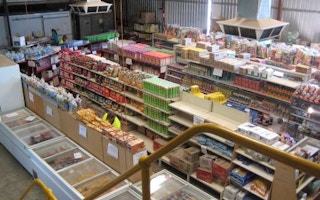The state’s biggest food relief charity has been forced to reject tonnes of food because of the lack of space in its warehouse, hampering its effort to efficiently distribute food to struggling families.
”A Riverina farmer offered us 64,000 kilograms of fresh oranges but we could only take half of it because our warehouse was too small,” said Foodbank NSW’s business development manager Tony Gatt. ”It is woefully inadequate.”
The charity saved 4 million kilograms of food from landfill last year, delivering 120 tonnes of food to 462 charities each week through its Wetherill Park warehouse. But it could do a lot more.
”We had to find 1000 square metres of extra space around our warehouse to store all the food,” he said. ”We need a warehouse three times as big.”
It is attempting to raise $2 million after a $2 million commitment from the state government to secure a new site. The warehouse is packed to the brim with nutritious food in damaged packaging, discontinued product lines and blemished fruits and vegetables, rejected by retailers and destined for landfill.
While Foodbank’s supplies have increased twentyfold since opening 12 years ago, it has not been able to meet growing demand.
Last year only 24 million kilograms of food was distributed by Foodbank nationally, when 50 million was needed.
”Up until the global financial crisis, charities generally served people with long-term physical disabilities and mental illnesses. But the number of the working poor, those who have just lost jobs, is increasing” Mr Gatt said.
Sixty per cent of the charities it serves are in regional NSW. On Monday, Peter West, founder of Ozzie Care in the Hunter Valley, filled his van with thousands of kilograms of food, from milk to sausages. He said the recent closure of an aluminium smelter and an unstable coal industry had forced hundreds of local families to seek food assistance from the charity.
”In the last seven months the number of families in need on our books has doubled,” he said.
Households in NSW throw away 800,000 tonnes of food worth $2.5 billion each year, the Environment Protection Authority said. Of the 400,000 tonnes wasted by retailers, 74 per cent is thrown out before it is sold and 30 per cent of restaurant food waste is left on customers’ plates.
John Hartley, chief executive of Future Directions International, is calling for mandatory recording and reporting of food wastage to be imposed on retailers to reduce food in landfill. ”Developed countries waste up to 50 per cent of food, mainly because of use-by dates,” Mr Hartley said.










